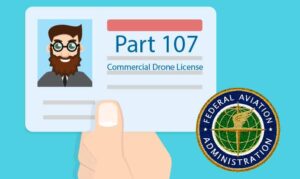
- Commercial drone pilots are being stopped while in the field by FAA officials. Often from local FSDOs (flight standards district offices) for spot checks. The officials asked the pilots to show their part 107 certification cards as well as their flight logs and maintenance records. For example, records of how often they change out their rotor blades. Spot checks like this are also called “ramp checks” which are unscheduled checks and/or surveillance made by FAA officials to ensure that flights are being made safely and in compliance with regulations.
- This is a requirement and responsibility under Part 107 rules. “A remote pilot in command must make available to the FAA upon request the small UAS for inspection or testing and any associated documents/records required to be kept under the rule.” —FAA’s Part 107 rules summary document
- Although ramp checks may not have happened much in the past for commercial drone pilots, it seems they will be happening more and more. So if you’re wondering whether your drone service provider needs to keep the items on this list with them while conducting commercial drone operations, the answer is: Yes, they definitely do.
- Preparation is a major way a drone pilot can avoid the wrath of the FAA!
- Drone pilots should use a preflight checklist before every flight. Preflight checklists should include identifying info, date/time/location of the flight, drone information, weather forecast check, purpose, check air space/get authorization/LAANC/waivers. Also, an inspection of the drone and components for good working condition, check firmware updates, calibrate if prompted, and set RTH Altitude (setting higher than the highest obstacle). UAS pilots should also keep a good maintenance record. This record shows the regular routine the pilot has for inspecting their drone for mechanical defects. Maintenance activities like calibration of sensors and replacement of parts need to be done periodically to make sure that the drone is always in tip-top condition. Keeping track of these is difficult without writing them down, thus the need to include them in drone flight logs.

FAA Part 107 License
When a pilot ensures they have this basic documentation on hand and can show it to the FAA when requested, on-site, it demonstrates to them that the drone service provider is consciously making an effort to fly safely and properly working within the FAA’s guidelines and laws.
A drone in many ways is like a tiny black box, all the flight data is being recorded and could be accessed by the FAA at any time. If the drone pilot isn’t considered safe the FAA could not allow them to fly the mission and even fine them.
List of Documents a Commercial Drone Pilot Should Always Have on Hand:
(best if most of this stuff is kept all together in a trusty three-ring binder)
• Part 107 certificate
• Driver’s license
• Insurance verification form
• Aircraft registration number and certificate
• Summary of FAA Part 107 Rules
• Drone flight log
• Flight operations manual
• Chart supplements for nearby airports (demonstrates knowledge of airport comm frequencies, traffic patterns, etc.)
• TFRs and NOTAMs at or near mission location
• LAANC authorization number (if applicable for airspace at mission location) Having this shows the FAA the pilot is making every attempt to have a safe and legal flight
• Maintenance log (demonstrates aircraft maintenance practices)
From The Editor:
Do you need to hire a professional drone service provider? To speak to an aerial data specialist, fill out a form, email us or for even faster response times, give us a call at (833) FLY-4YOU or (833) 359-4968. Check out our transparent pricing at Drone Photography Pricing and watch this space as we expand on the above topics and more over the coming weeks and months. If you like this post, feel free to click the share button at the bottom of the page. We appreciate you helping us by spreading the content we share on our blog.
- Drones That Fight Fire With Fire - December 8, 2022
- How’s Your Drone Service Provider At Crew Management? - November 14, 2022
- Does Your Drone Service Provider Incorporate Safety Procedures? - November 9, 2022

